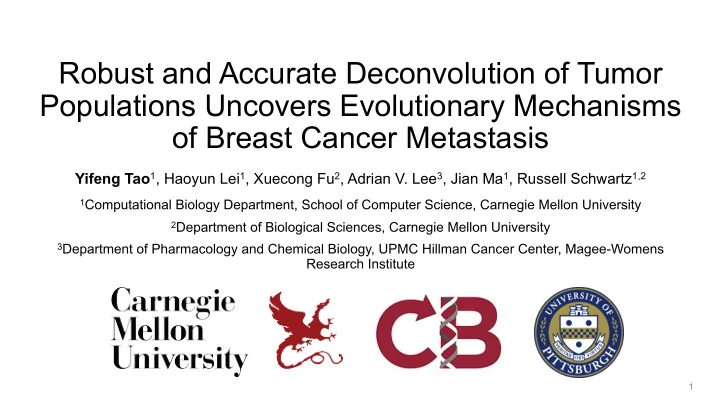

Robust and Accurate Deconvolution of Tumor Populations Uncovers Evolutionary Mechanisms of Breast Cancer Metastasis Yifeng Tao 1 , Haoyun Lei 1 , Xuecong Fu 2 , Adrian V. Lee 3 , Jian Ma 1 , Russell Schwartz 1,2 1 Computational Biology Department, School of Computer Science, Carnegie Mellon University 2 Department of Biological Sciences, Carnegie Mellon University 3 Department of Pharmacology and Chemical Biology, UPMC Hillman Cancer Center, Magee-Womens Research Institute 1
Background: cancer progression and metastasis • Tumor phylogeny: tumor cells follow a clonal evolution process • Metastasis: transfer from primary site to other sites • Heterogeneous tumor populations/clones even from same tissue 2
Background: breast cancer metastasis and bulk data • Breast cancer: second common cause of death from cancer in women • Breast cancer metastasis (BrM) causes majority of those deaths • Mechanism of tumor progression during metastasis relies on phylogenetic analysis • scRNA rarely available due to years between sample collection • Robust and accurate deconvolution (RAD) of bulk tumor samples is essential 3
Approach: evolution inference of BrM from bulk RNA • To boost RAD: knowledge-based gene module (DAVID; DW Huang et al. 2009 ) • Core of RAD: bulk sample deconvolution • Based on RAD-unmixed populations: phylogeny inference (MEP; Tao et al. 2019 ) a b c Module 1 or or ? 100% Cancer biology Module 3 Module 2 0% breast brain ovary bone × ≈ Computational model 4
RAD formulation: biologically inspired NMF • RAD formulated as non-negative matrix factorization (NMF) • B: bulk RNA of samples; C: RNA of populations; F: fractions of populations • Data noisy and correlated à gene module compression • Non-convex and no efficient optimizer à RAD three-phase optimizer • k not known in prior à cross-validation 5
RAD phase 1: multiplicative update warm-start • Revised multiplicative update (MU) rules • Loop until objective stops decreasing • MU is non-increasing objective only for general NMF problem ( DD Lee et al. 2000 ) • Fast to converge to a reasonable solution 6
RAD phase 2: coordinate descent • Coordinate descent • Optimizes over C and F iteratively until convergence • Subproblems solved as quadratic programming problems ( MS Andersen et al. 2013 ) • Computationally expensive compared with MU warm-start • Further reduces loss by ~5-30% 7
RAD phase 3: minimum similarity selection • Minimum similarity selection • Repeat random initialization, phase 1 and phase 2 for multiple (e.g., 10) times • Select solution with minimum similarity • Better solution: components/populations orthogonal from each other C 2 C 2 C 1 C 1 Solution 1: ✘ Solution 2: 8
Population number estimation via RAD • Masking trick for cross-validation (CV) • Select k that achieves minimum CV error • Masked RAD algorithm exits! 9
Datasets and experiment design Dataset Gene module Ground truth C and F Purpose Simulated ( K Known Known • Evaluate effect of gene module Zaitsev et al. 2019 ) GSE19830 ( SS Knowledge base Known • Evaluate effect of gene module Shen-Orr et al. 2010 ) • Evaluate RAD accuracy on estimating C, F, and k BrM ( L Zhu et al. Knowledge base Unknown • Understand breast cancer 2019 ) metastasis mechanism 10
Gene modules facilitate robust deconvolution • Simulated datasets: gene module known • Too small module size à fragile deconvolution • Too large module size à worse estimation 11
RAD detects correct number of cell components • GSE19830: three cell types known in advance • BrM: ground truth cell types unknown GSE19830 BrM 12
RAD estimates populations more accurately • Outperforms three competing methods on GSE19830 dataset • Gene module inferred from knowledge base improves RAD as well a b c d e 13
Common evolutionary mechanisms of BrM • Infer phylogenies from RAD-unmixed populations • Minimum elastic potential (MEP; Nei et al. 1987, Tao et al. 2019 ) • Four cases in total (one shown) • Common early pathway-level events • ↓ PI3K-Akt ( PK Brastianos et al. 2015 ) • ↓ Extracellular matrix (ECM)-receptor interaction • ↓ focal adhesion ( M Nagano et al. 2012 ) 14
Conclusion and future work • Deconvolution of bulk data is the key to understanding the BrM progression • We propose RAD, a toolkit that accurately and robustly estimates the number of cell populations ( k ), expression profiles of cell populations (C), and fractions of populations (F) • Through RAD, we find the loss of PI3K-Akt, ECM-receptor interaction, and focal adhesion emerge as the common early pathway-level events of BrM • Integrate single cell data of metastatic samples to improve RAD performance 15
Acknowledgments Dr. Russell Schwartz Dr. Jian Ma Dr. Adrian V. Lee Haoyun Lei Xuecong Fu Follow @Yifeng_Tao CMUSchwartzLab/RAD 16
Recommend
More recommend